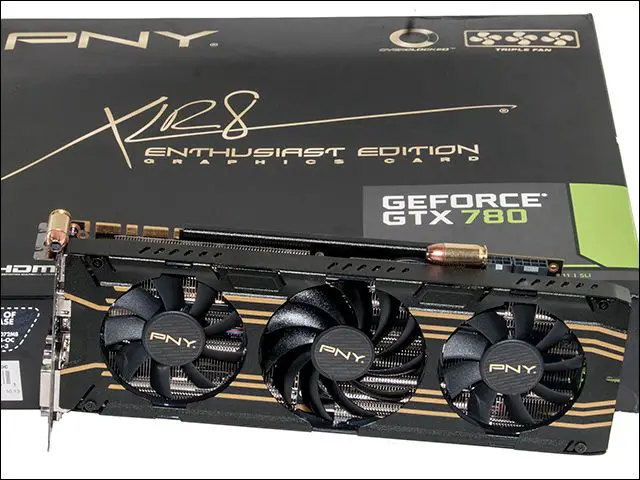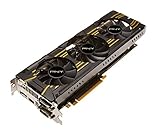A Closer Look at the PNY GeForce GTX 780 XLR8 OC

Let’s start with the 800lb guerrilla in the room: that is one down right massive shipping container. Compared to even a full sized ATX motherboard’s container this box is big. To be precise this rather aggressive black and green box is approximately 400mm by 355mm by 75mm in size. Usually we stick a 45 hollow point in to help put things in perspective but this box is so big that the big old forty fives looks as small as a couple 22 shorts! So while we felt the need to include them out of custom it was not going to help put the size of this box in perspective.

To help put it in proper perspective we could have uses a ‘banana for scale’ but even that can be confusing so we used our old EDC of choice a Kit Carlson designed Canyon River Knife & Tool M16 SFG. When open and fully extended this knife is 8.25 inches from the tip of its tanto blade to the end of its carbon fibre clad butt, and it is dwarfed by this box. Needless to say finding room for storing this box will be a larger than normal issue, but at least it will be easy to find if you ever need it!
On the positive side, all this extra real-estate has been put to good use as the back of the shipping container plenty of information to help make an informed decision down right easy. Though once again PNY has distained the use of a picture of the actual XLR8 OC and the front is denude of any such images. Considering a full sized picture would have easily fit we find it conspicuous by its absence.

Making this shipping container so large also has another benefit: it allows for excellent internal protection. Unlike most cards, the PNY GeForce GTX 780 XLR8 OC comes nestled in thick foam which can take a lot of damage before the card would even notice it.

Unfortunately, while this box is literally big enough to store two of the PNY GeForce GTX 780 XLR8 OC’s inside, PNY have skimped out on the accessories. In grand total you get a single dual 6-pin to single 8-pin PCI-E adapter, a driver CD, and a digital to analog adapter. Overall we were expecting even more from this Enthusiast Edition card, but given the more value oriented nature it is somewhat understandable. On the positive side this is the exact same accessory bundle which ships with the much more expensive GeForce GTX 780Ti XLR8 we recently reviewed.

Like any GeForce GTX 780 the new PNY XLR8 OC uses a 7.1billion, 28nm based GK110 core which has 2,304 out of a possible 2,880 Cuda Cores enabled. Also like a stock GeForce GTX 780, the 780 XLR8 OC uses three gigabytes worth of GDDR5 memory attached to a 384-bit bus. This however is where the similarity ends between a reference GeForce 780 and this custom 780. As mentioned in the introduction, PNY has used highly binned GK110 cores and given these golden chips an extremely high factory overclock and even overclocked the memory so that instead of 288GB/s of bandwidth it now is rated for 298GB/s.

As with anything in life there is no free lunch and with such increased performance comes increased heat output. This means the, very decent for what it is, ‘reference’ NVIDIA cooler would not be good enough to cool the hotter running parts. Instead of that ‘stock’ cooler PNY uses on numerous of their other Enthusiast Edition cards, they have opted for a triple fan custom design. A design which is not only able to handle the increased heat loads with aplomb but do so while actually decreasing the noise profile of the 780 XLR8 OC compared to a reference 7 series video card.

This custom cooler is able to do all this because under its metal fascia lies three heatsinks equipped with a total of seven 6mm heatpipes. These heatpipes are able to handle massive amounts of heat before becoming overloaded. To then transfer the heat from the fin arrays to the air PNY have opted for a rather odd configuration of a single 90mm flanked by two 80mm fans in a down draft configuration. Working together these fans can move substantial amounts of air at relative low RPMs – which in turn keeps noise levels to a minium. As an added benefit they push all this air over the board’s various components not directly attached to the heatsink, thus keeping them cool as well.

This custom cooler design is and of itself very impressive, but what we found more impressive still was the fact that PNY was able to keep this custom cooler to a two slot form factor. This will make SLI’ing a pair – or more – of these cards a lot easier on most motherboards and the added room will help keep cool air reaching the fans.

The only real negative to this custom cooler design is that it makes an already large video card even larger. PNY may have once again used a reference GeForce 780’s PCB, but the heatsink and cowling do overhang the board. This stretches the length of this card from 10.5 inches to an approximate 11.8 inches. This would be more than tolerable, but a good quarter inch of this added length has been done solely for aesthetic reasons. We have zero issues with PNY needing more room so as to have more cooling fins in their cooling towers, but this is simply making a card longer than it needs be for the sake of looks. On the positive side it is a very striking looking card and its black and with gold racing stripes certainly would make an excellent centerpiece for any LAN party system.

Also on the positive side is PNY has been able to keep the power requirements within reason – 250 watts – and as such this factory overclocked XLR8 OC 780 only needs a single 6-pin and a single 8-pin PCIE power connectors.

Oddly enough, PNY has not only decided against using a backplate for the PCB but they have also not included a backplate for the heatsink. This is odd as this is not a light heatsink and a metal reinforcing bracket around the core itself would have not raised an eyebrow. We assume PNY felt the stock screws did not need reinforcing, but it certainly is less than optimal nonetheless.

On the positive side PNY have also not messed with NIVIDIA’s reference output selection. In fact this rear two slot bracket is reference NVIDIA through and through. This means the same selection of two DVI connectors stacked above the other, a single full size HDMI, and a single DisplayPort connector. Also like any reference design the rear exhaust ports consist of one row of vents plus two additional vents below the row. While some hot air will escape via these vents they are not entirely needed as this cooler is meant to exhaust the lion’s share of heat inside your case. As such we would recommend a good case with good internal air flow. Doing otherwise will negate a lot of the benefits associated with custom coolers and this high performance card will thermally throttle itself within a safe operating temperature range.











